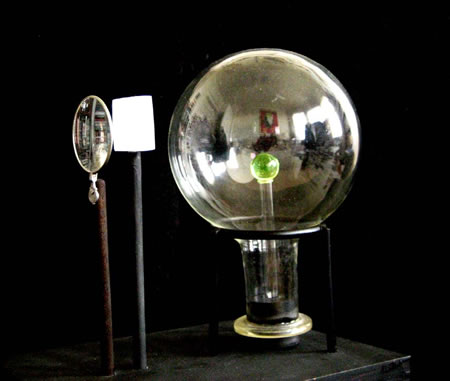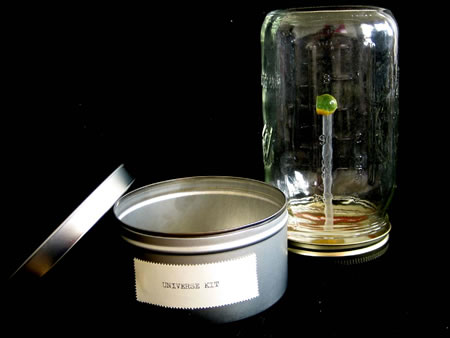Science Fiction
Dictionary
A B C D E F G H I J K L M N O P Q R S T U V W X Y Z
Universe Kits Now Available From Jonathon Keats

Conceptual artist Jonathon Keats is making universe kits, devices for fabricating new universes at the whim of the user, available for the first time to the public.

(Early prototype for the do-it-yourself universe Kit [credit: Keats])
This piece of conceptual art has a little something extra going for it. In 1957, physicist Hugh Everett formulated what is called the many-worlds interpretation (MWI) of quantum mechanics. Everett's work came as a response to the dissatisfaction felt by many physicists with the idea that subatomic events happen in a purely probablistic way. According to Everett, when a subatomic system consisting of a superposition of two likely states reduces to just one, the universe has "forked" into two distinct universes. MWI adherents would say that every possible outcome to every event exists in its own version of the universe.
After using the above prototype to make uncounted unverses, Mr. Keats felt the need to share. "Creating all those universes seemed a little selfish," he confides.
I had the opportunity to briefly interview Jonathan Keats via email.
-
Technovelgy: When did you settle on the idea of a do-it-yourself universe kit?
Jonathon Keats: All of my art projects are thought experiments, in which I encourage others to explore big ideas with me - conundra that I can't unravel alone. I attempt to accomplish this by creating scenarios in which those ideas are physically embodied, whether in a building (as in the Atheon) or a machine (as in the universe generator). In this case, I was interested in considering the implications of Hugh Everett's many-worlds interpretation of quantum mechanics, which in the past several years has come to scientific and public prominence.
The kits, which I developed over the last year, are intended to make the exploration hands-on. If Everett's interpretation is right, anyone with a few minutes to spare can literally subdivide the universe - effectively making two (or more) worlds from one - by putting together a couple simple components with a bit of chewing gum. The process is deliberately mundane, and, as you'll see from the photos, the generator itself is pedestrian in appearance. At a glance, the universe kit is manifestly absurd, but so too is Everett's interpretation. Only upon further consideration does the notion of quantum mechanics at a macro scale, with the implication of multiple parallel universes, become profound.

(Universe Kit ready for sale [credit: Keats])
Technovelgy: Please discuss some of the science behind your kit.
Jonathon Keats: Everett's theory addressed the question of how a subatomic particle can exist in a quantum superposition - for example being in two places at once - until someone observes it, at which point the observer finds it to be in only one place at a time. The explanation Everett gave is that the particle remains in both places when it's observed, but the observer's entire universe splits as the measurement is made, so that from that moment forward there are two separate observers living in separate universes, both identical except for the observed location of that single subatomic particle.
The kit uses a quarter-inch sphere of uranium-doped glass to provide a steady supply of subatomic particles, placed in close proximity to a sliver of scintillating crystal which measures the radioactive decay, effectively observing a quantum process - and splitting the universe.
Technovelgy: Of course, I'm curious if you did any related sf reading.
Jonathon Keats: 'm very interested in science fiction, and in a way my art derives from the same impulse as stories by Asimov or Gibson. Like them, I'm interested in reflecting on our own world by standing back and asking 'What if…?' The difference is that the narratives I create are open-ended, evolving as people encounter them and interact with them, whether physically or through the blogosphere. Perhaps you could call it live-action sci-fi.
By the way, I certainly don’t want to imply that the above approach is superior to sci-fi in any way. In fact I believe strongly enough in fiction to write it myself. Not sci-fi, but fables set once upon a time. Random House will be publishing my newest work, called "The Book of the Unknown" early next year:
Technovelgy: As far as future plans are concerned, have you really submitted a plan to install two-mile-long scintillating crystal stacks into Yucca mountain?
Jonathon Keats: When I started to produce the kits, I formed a company called Universes Unlimited. In keeping with the capitalist mandate to expand, I was naturally inclined to begin building factories that could fabricate universes at an industrial scale. The U.S. government's proposed Yucca Mountain Nuclear Waste Repository seemed to be an ideal site for the first of these plants, since the radioactivity of the dump could be repurposed to make new worlds. Moreover I figured that the government would benefit: Now that we've pretty well destroyed this world, generating a googolplex of alternate universes with a googolplex of possible outcomes could be our only chance at redemption.
I'm working on a proposal now, which I'll be sending to the Department of Energy in the next couple weeks. The crystal stacks will look like chimneys protruding from the landscape, glowing in the night.
It consisted of two twelve-foot metal disks with grid-like surfaces, one on the floor and one on the ceiling directly over the other. They were connected by cables to the electrical machinery, and their grid-like surfaces shone faintly with wan blue light or force.Between the two disks, floating unsupported in the air, hung a cloud of tiny sparks of light. It looked like a swarm of minute golden bees, countless in number, and the swarm was lenticular in shape. Mounted near this weird thing were several instruments that looked a little like telescopes, though unfamiliar in design. They seemed to be trained on that thick little cloud of shining sparks...
"Fessenden's eyes had been following my stupefied change of expression. He said calmly, "Yes, Bradley, it is true. That is a tiny, self-sustaining universe, with its own suns, nebulae and worlds. Everything in it, down to the atoms which compose it, is infinitely smaller in scale than our own. But it is a real universe, like our own."
(Read more about Hamilton's miniature universe)
Philip K. Dick had similar thoughts in his 1953 story The Trouble With Bubbles.
The Worldcraft bubble glittered, catching the light...Lora turned on the bubble. It glowed, winking into brilliance...
She increased the magnification, bringing the microscopic central planet into focus...
Again Lora increased the magnification. The central planet grew, showing a pale green ocean lapping faintly at a low shoreline. A city came into view, towers and broad streets, fine ribbons of gold and steel. Above, twin suns beamed down, warming the city. Myriads of inhabitants swarmed about their activities...
(Read more about Dick's Worldcraft Bubbles)
Mr. Keats is generously making his do-it-yourself universe kits available for just $20; they will be sold exclusively through Modernism Gallery in San Francisco. A grand opening has been scheduled for Thursday, November 20th from 5:30 to 8:00 PM.

(Universe Kits ready for sale [credit: Keats])
Readers interested in Jonathon Keats' work may want to enter the Atheon Temple To Science to see another of his conceptual art works. Thanks to Mr. Keats for the interview on Universe kits; see also his press release.
Scroll down for more stories in the same category. (Story submitted 11/2/2008)
Follow this kind of news @Technovelgy.| Email | RSS | Blog It | Stumble | del.icio.us | Digg | Reddit |
Would
you like to contribute a story tip?
It's easy:
Get the URL of the story, and the related sf author, and add
it here.
Comment/Join discussion ( 0 )
Related News Stories - (" Living Space ")
Elegant Bivouac Shelter Produces Water And Electricity
'There was nowhere on the planet where science and technology could not provide one with a comfortable home...' - Arthur C. Clarke.
AI-THu Shapeshifting Transformer Home
'Its slack walls tightened, bulged, were crossed by ripples and waves of movement.' - Fritz Leiber, 1943.
With Mycotecture, We'll Just Grow The Space Habitats We Need
'The only real cost was in the plastic balloon that guided the growth of the coral and enclosed the coral's special air-borne food.' - Larry Niven, 1968.
Vast Apartment Living Will Get Even More Vast
'What is your population', I asked. 'About eighty millions.' - Louis Tucker, 1929.
Technovelgy (that's tech-novel-gee!) is devoted to the creative science inventions and ideas of sf authors. Look for the Invention Category that interests you, the Glossary, the Invention Timeline, or see what's New.
Science Fiction
Timeline
1600-1899
1900-1939
1940's 1950's
1960's 1970's
1980's 1990's
2000's 2010's
Current News
Natural Gait With Prosthetic Connected To Nervous System
'The leg was to function, in a way, as a servo-mechanism operated by Larry’s brain...'
Woman Marries Computer, Vonnegut's Dream Comes True
'Men are made of protoplasm... Lasts forever.'
Spidery 'Walk Me' Toyota Autonomous Wheel Chair Like Star Wars
Walk along with the emperor.
Dancing Robots Taught Dance Moves
'A clockwork figure would be the thing for you...'
Proof Of Robothood - Not A Person
'Who are you people? - Show 'em.'
Indonesian Clans Battle
'The observation vehicle was of that peculiar variety used in conveying a large number of people across rough terrain.'
The 'Last Mile' In China Crowded With Delivery Robots
Yes, it's a delivery robot. On wheels.
Tornyol Microdrone Kills Mosquitoes
'The real border was defended by... a swarm of quasi-independent aerostats.'
PLATO Spacecraft, Hunter Of Habitable Planets, Now Ready
'I ... set my automatic astronomical instruments to searching for a habitable planet.'
Factory Humanoid Robots Built By Humanoid Robots
'...haven't you a section of the factory where only robot labor is employed?'
iPhone Air Fulfils Jobs' Promise From 2007 - A Giant Screen!
'... oblongs were all over the floor and surfaces.'
ChatGPT Now Participates in Group Chats
'...the city was their laboratory in human psychology.'
iPhone Pocket All Sold Out!
'A long, strong, slender net...'
Did The Yautja Have These First?
What a marvel of ingenuity the little device was!
Jetson ONE Air Races Begin, Can Air Polo Be Far Behind?
'If you're one of those rarities who haven't attended a rocket-polo "carnage", let me tell you it's a colorful affair.'
Will Space Stations Have Large Interior Spaces Again?
'They filed clumsily into the battleroom, like children in a swimming pool for the first time, clinging to the handholds along the side.'
